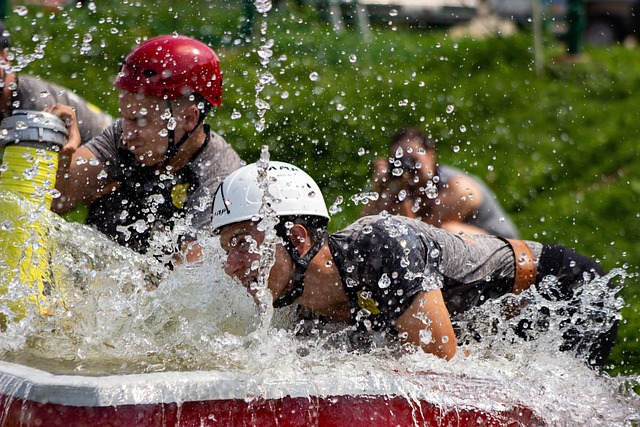Museums are leveraging advanced technologies like VR, AR, 3D printing, and sensor-based interactions (including unique hatta activities) to create immersive, interactive exhibits that transcend traditional displays. These innovative tools enable visitors to engage with history, science, and art in dynamic ways, from stepping into historical events to exploring distant worlds. By offering hands-on experiences, these technologies enhance learning, attract a broader audience, and personalize the visitor journey, ensuring museums remain vibrant and relevant in the digital age.
“Welcome to the future of museums, where cutting-edge technology transforms static displays into dynamic, interactive experiences. This article explores how innovative tools like virtual reality, augmented reality, and sensor-based interactions revolutionize museum visits. From engaging exhibits that captivate modern visitors to Hatta Activities blending art and science, we delve into the role of tech in enhancing user engagement and educational outreach. Discover how museums are using these advancements to create immersive environments that leave a lasting impression.”
- The Role of Technology in Shaping Museum Experiences
- Interactive Exhibits: Engaging the Modern Visitor
- Immersive Technologies for a Future-Forward Museum
- Hatta Activities: Blending Art, Science, and Innovation
- Virtual and Augmented Reality in Museum Curating
- Sensor-Based Interactions: Enhancing User Engagement
- The Impact of Cutting-Edge Technology on Educational Outreach
The Role of Technology in Shaping Museum Experiences

Technology is transforming the way museums engage with their visitors, creating immersive and interactive experiences that go beyond traditional static displays. By integrating cutting-edge technology into exhibits, museums can offer visitors hands-on opportunities to explore and interact, fostering a deeper connection with the displayed content. Augmented reality (AR) and virtual reality (VR) are prominent tools in this shift, enabling visitors to step inside historical events or peer into distant worlds, making abstract concepts tangible and memorable.
These innovative technologies not only enhance learning but also encourage visitor participation through interactive exhibits. Hatta activities can be designed to challenge, educate, and entertain, attracting a wider audience with diverse interests. The role of technology in shaping museum experiences is to create dynamic environments that adapt to individual visitors’ preferences, providing a personalized journey through history, science, or art.
Interactive Exhibits: Engaging the Modern Visitor

Interactive exhibits are transforming the way modern visitors engage with museums, making their experience more immersive and engaging. By incorporating cutting-edge technology like touch screens, virtual reality (VR), and augmented reality (AR), museums can offer dynamic and interactive experiences that attract a wider audience. These innovative displays allow visitors to explore historical artifacts and stories in novel ways, enhancing their understanding and appreciation of the exhibits.
Hatta activities, such as VR simulations or AR-enhanced tours, can transport visitors back in time, enabling them to witness historical events or interact with digital representations of ancient cultures. This level of interactivity not only captivates visitors but also fosters a deeper connection to the museum’s collection. By combining education and entertainment, these futuristic exhibits ensure that museums remain relevant and exciting for contemporary audiences.
Immersive Technologies for a Future-Forward Museum

The future of museums lies in their ability to immerse visitors in captivating experiences, and cutting-edge technology plays a pivotal role in achieving this. Interactive exhibits that leverage virtual reality (VR), augmented reality (AR), and 3D projection mapping offer visitors a chance to engage with exhibits on a whole new level. These technologies allow for the creation of dynamic environments where visitors can step into historical scenes, interact with digital art, or even manipulate virtual objects, fostering a deeper understanding and appreciation of the displayed content.
Imagine stepping into a reenactment of an ancient battle, exploring a digital replication of a lost city, or interacting with life-size sculptures that seem to change before your eyes. Such immersive experiences not only entertain but also educate, encouraging visitors to participate actively in their cultural heritage. By integrating these innovative technologies, museums can attract a wider audience, especially younger generations who are accustomed to interactive and multi-sensory learning environments, thus ensuring their relevance and vitality in the digital age.
Hatta Activities: Blending Art, Science, and Innovation

At the forefront of pioneering museum experiences is the integration of Hatta activities that seamlessly blend art, science, and innovation. These interactive exhibits don’t just showcase historical artifacts; they become immersive journeys where visitors actively participate in unraveling creative and technological advancements. By combining cutting-edge technology with traditional artistic expression, museums offer a unique platform for exploration and discovery.
Hatta activities transform static displays into dynamic environments that captivate all senses. Through virtual reality simulations, 3D printing workshops, and interactive multimedia installations, visitors engage in hands-on learning experiences. This blend of art and science fosters creativity, encourages critical thinking, and instills a deeper appreciation for the ever-evolving relationship between technology and human expression.
Virtual and Augmented Reality in Museum Curating

Virtual and Augmented Reality (VR/AR) technologies are transforming the way museums curate and present exhibits, offering visitors immersive experiences that were once unimaginable. By integrating VR/AR into their displays, museums can create interactive, engaging environments where users can explore historical artifacts or artistic creations from entirely new perspectives. These cutting-edge tools enable curators to bring static displays to life, allowing visitors to interact with content in real-time and engage in hands-on learning experiences.
Hatta activities can range from virtual tours of ancient civilizations to augmented reality simulations that overlay digital information onto physical exhibits. VR/AR enhances visitor comprehension by providing contextual details, animations, or 3D models that deepen their understanding of the displayed objects and themes. This technology also caters to diverse learning styles, accommodating visual, auditory, and kinesthetic learners by offering multiple avenues for knowledge acquisition.
Sensor-Based Interactions: Enhancing User Engagement

In the realm of futuristic museum exhibits, sensor-based interactions play a pivotal role in enhancing user engagement and immersing visitors in dynamic learning experiences. By integrating sensors into exhibit designs, museums can create interactive environments that respond to visitors’ actions, fostering hands-on exploration and personalized interactions. This technology enables visitors to become active participants rather than passive observers, making their museum visit more captivating and memorable.
For instance, sensor-driven exhibits could allow visitors to manipulate digital elements by simply gesturing or touching, triggering educational content or immersive multimedia experiences. These interactive activities, often referred to as “hatta” moments, can range from exploring virtual landscapes to manipulating 3D models, providing a unique and personalized connection with the exhibited material. Such innovations not only attract a broader audience but also encourage visitors to spend more time appreciating and understanding the artwork or historical artifacts on display.
The Impact of Cutting-Edge Technology on Educational Outreach

Cutting-edge technology is transforming how museums engage and educate their visitors, particularly through interactive futuristic exhibits. Virtual reality (VR) and augmented reality (AR) allow visitors to immerse themselves in historical events or explore distant worlds, enhancing their understanding and appreciation of displayed artifacts. These technologies facilitate hands-on learning experiences that were previously unimaginable, making complicated concepts more accessible and engaging for a wide range of audiences, from students to seniors.
Interactive exhibits powered by advanced technology also encourage visitor participation, fostering a sense of community and collaboration within the museum setting. Hatta activities, such as QR code scans or touch-sensitive displays, can trigger multimedia content, encouraging visitors to delve deeper into topics that pique their interest. This personalized learning approach not only enriches individual experiences but also promotes active learning and knowledge retention, ultimately making educational outreach more effective and enjoyable for everyone involved.
Museums are evolving, embracing cutting-edge technology to create immersive and interactive exhibits that captivate visitors. By leveraging virtual reality, augmented reality, sensor interactions, and more, institutions can offer dynamic experiences that blend art, science, and innovation, such as Hatta Activities. This future-forward approach not only enhances visitor engagement but also expands educational outreach, ensuring museums remain vibrant hubs of discovery in the digital age.
